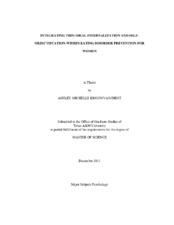| dc.description.abstract | A cross-sectional and longitudinal examination of thin-ideal internalization and self-objectification was conducted within the context of an eating disorder prevention program. The sample consisted of 177 undergraduate women enrolled in a sorority between the ages of 18 and 22 who participated in a dissonance-based eating disorder prevention program. Participants completed self-report assessments at baseline, post-intervention, 5-month, and 1-year follow-up. Measures included the Ideal-Body Stereotype Scale-Revised, Self-Objectification Questionnaire, Body Shape Questionnaire, and Eating Disorder Examination-Questionnaire. A cross-sectional path analysis indicated that thin-ideal internalization and self-objectification predict each other and both predict body dissatisfaction, which in turn, predicts eating disorder symptoms. A longitudinal examination of the prevention program indicated that participants showed significant reductions in thin-ideal internalization, self-objectification, body dissatisfaction, and eating disorder symptoms after participating in a cognitive dissonance eating disorder prevention program. Significant reductions of all symptoms were maintained at 1-year follow-up, with the exception of self-objectification, which had a significant reduction up to the 5-month assessment. A longitudinal path analysis indicated that post-intervention thin-ideal internalization and self-objectification predicted body dissatisfaction at 5-month follow-up assessments which in turn predicted eating disorder symptoms at this same time point. This model was replicated for 1-year follow-up body dissatisfaction and eating disorder symptoms with the exception of the direct path from self-objectification to body dissatisfaction. Assessment of temporal sequence of change between self-objectification and thin-ideal internalization revealed that neither variable significantly predicted meaningful change in the other variable. Finally, individuals who showed meaningful change in self-objectification before showing meaningful reduction in thin-ideal internalization from baseline to post-intervention assessments had greater reductions in eating disorder symptoms 1-year following the intervention. Collectively, these results suggest that eating disorder prevention programs should focus on targeting both thin-ideal internalization and self-objectification simultaneously to increase further the reduction of eating disorder symptoms. | en |


